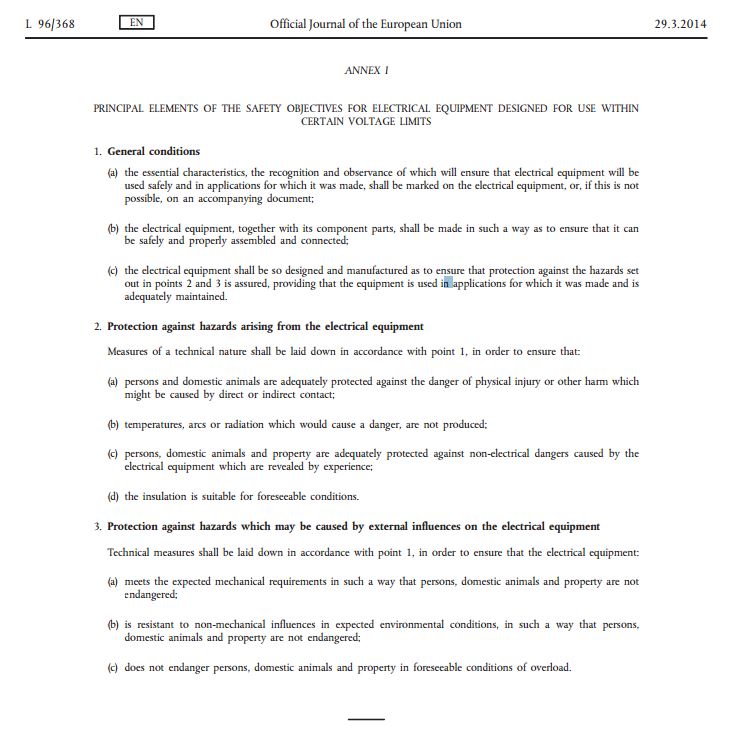F2 Labs is constantly working to help customers better understand their responsibilities in complying with CE marking Directives that may or may not apply to their equipment. Previously we published an article about the relationship between the Low Voltage Directive 2014/35/EU and the Machinery Directive 2006/42/EC. Besides the LVD’s relationship with the MD, a question that comes up over and over is the need to comply with the Low Voltage Directive 2014/35/EU for some products that are seemingly not in the scope of this law at all.
The Low Voltage Directive 2014/35/EU scope of applicability is indicated in Annex I, paragraph 2, and is:
This Directive shall apply to electrical equipment designed for use with a voltage rating of between 50 and 1 000 V for alternating current and between 75 and 1 500 V for direct current, other than the equipment and phenomena listed in Annex II.
This means that electrical equipment with an input power of from 50 to 1,000 volts AC and from 75 to 1,500 volts DC are within the scope of the law. Battery powered devices that operate with an input power of 12 volts DC are therefore excluded from the law.
Unfortunately, it is not that simple. For example, if you have a product that operates on 12 volts DC power but you supply an AC/DC adapter with your product when you ship to the EU then your product is operating with an input power of 230 volts AC and it is within the scope of the Low Voltage Directive. Similarly, if you do not supply the power supply with the product but you specify that an AC/DC power supply must be used with your product then it is considered an AC powered product and therefore will operate at 230 volts AC power and is within the scope of the LVD.
Also note that both the Radio and Telecommunications Terminal Equipment Directive 1999/5/EC and the Radio Equipment Directive 2014/53/EU require compliance with Annex I of the LVD no matter the voltage.
See below Article 3 (1.) (a) from the R&TTE Directive 1999/5/EC:
- The following essential requirements are applicable to all apparatus: (a) the protection of the health and the safety of the user and any other person, including the objectives with respect to safety requirements contained in Directive 73/23/EEC, but with no voltage limit applying;
Note that Directive 73/23/EEC was the Low Voltage Directive in effect when 1999/5/EC was written. By law that refers to, now, the Low Voltage Directive 2014/35/EU.
See below Article 3 (1.) (a) from the Radio Equipment Directive 2014/53/EU (also called the “RED”):
- Radio equipment shall be constructed so as to ensure: (a) the protection of health and safety of persons and of domestic animals and the protection of property, including the objectives with respect to safety requirements set out in Directive 2014/35/EU, but with no voltage limit applying;
It is informative at this point to also point out that both the R&TTE 1999/5/EC and the RED 2014/53/EU exclude the Low Voltage Directive from being applicable to the equipment if either R&TTE or RED are applicable.
See below an excerpt from recital (46) from the R&TTE Directive 1999/5/EC:
…whereas Directives 73/23/EEC and 89/336/EEC will no longer apply to apparatus within the scope of this Directive, with the exception of protection and safety requirements and certain conformity assessment procedures,
And also see below recital (7) from the RED 2014/53/EU:
(7) The objectives with respect to safety requirements laid down in Directive 2014/35/EU are sufficient to cover radio equipment, and should therefore be the reference and made applicable by virtue of this Directive. In order to avoid unnecessary duplications of provisions other than those concerning such requirements, Directive 2014/35/EU should not apply to radio equipment.
This can be confusing unless you read it a few times. What it means, in the cases of both the R&TTE Directive 1999/5/EC and the RED 2014/53/EU, is this:
- Annex I from the Low Voltage Directive is applicable to equipment within the scope of either “radio” Directives regardless of the power input. Therefore if your device has a tiny coin cell battery and a wireless module and no connection to AC mains power you must comply with Annex I of the LVD.
- In these cases only Annex I from the LVD is applicable and nothing else from the LVD.
- The LVD will not be referenced on the EU declaration of conformity for the product because compliance with Annex I of the LVD is presumed when compliance to either R&TTE or RED are claimed. Therefore the LVD itself is excluded, only Annex I is applicable and that is through Article 3 (1.) (a) of both the R&TTE Directive 1999/5/EC and the RED 2014/53/EU.
So, the next question is, “What is Annex I of the LVD?” See below:

Compliance with Annex I of the LVD will require, in most cases, testing using an applicable harmonized EN standard from the official list published in the Official Journal of the European Union. The latest available list was published on July 8, 2016 and is published here: LVD standards OJ List.
F2 Labs is here to help. Have a question or a comment? We can be contacted via this link. We can be reached by phone at 877-405-1580 and are here to help you.
